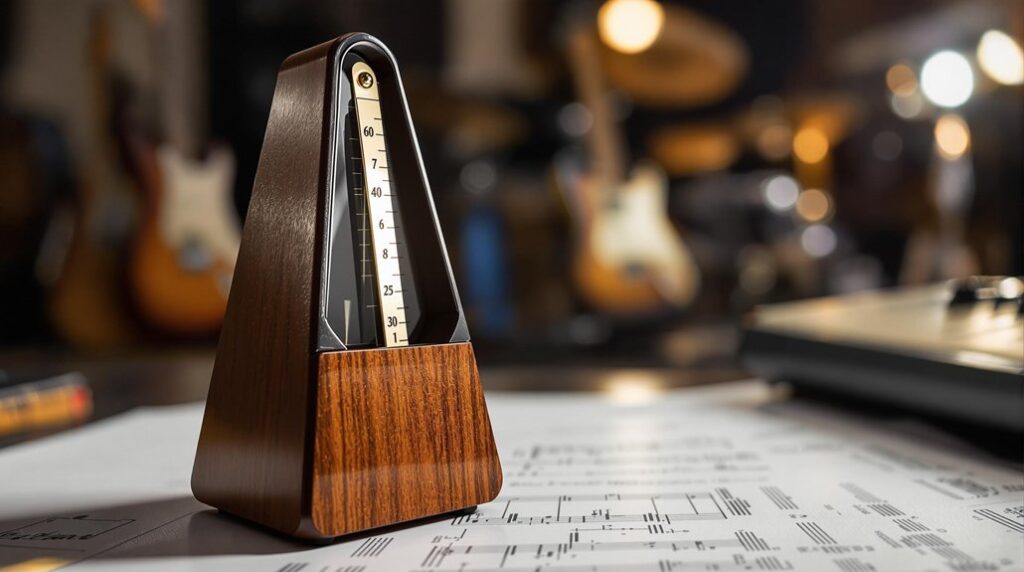Intervals, defined as the distance between two pitches, are fundamental in music theory and serve as the building blocks of melody. They come in various types, including harmonic and melodic, which can be further classified by numeric size and quality—such as perfect, major, minor, augmented, and diminished. Intervals influence emotional nuance in music; for example, major intervals often convey brightness while minor intervals evoke somberness. Mastery of interval recognition is vital for creating scales, chords, and melodies, and is essential for both performers and composers aiming to enhance their musical expression and theoretical understanding. Insights into practical applications and advanced theory underscore their significance.
Key Takeaways
- Intervals measure the distance between two pitches and are fundamental in music theory.
- Numeric size of intervals is determined by counting lines and spaces between notes.
- Interval quality includes perfect, major, minor, augmented, and diminished, affecting emotional expression.
- Intervals serve as foundational elements in musical compositions and aid in creating melodies.
- Mastery of intervals is crucial for performers and composers, enhancing technical proficiency and creativity.
Definition of Intervals
Intervals, a cornerstone of music theory, measure the distance between two pitches and are foundational elements in the construction of musical structures. They can be classified into two primary types: harmonic intervals, where notes are played simultaneously, and melodic intervals, where notes are played sequentially. The distinction between these types is vital for understanding their respective roles in harmony and melody.
The interval significance extends beyond mere classification; it influences the emotional and relational qualities of notes within a musical piece. For instance, lower pitches often suggest foreboding, while higher pitches can induce lightness or anxiety.
Major scale intervals, categorized as perfect or major, serve as the basic building blocks for scales, chords, and melodies. These intervals provide a structural framework that composers and musicians rely on to create harmony and tension within their works.
Accurate interval recognition is essential for anyone delving into music theory, as it facilitates a deeper comprehension of musical relationships. Each interval is named based on its numeric size and quality, offering a consistent and precise method to identify and analyze musical elements.
This consistent framework is indispensable for both theoretical analysis and practical application, underscoring the profound significance of intervals in the domain of music theory.
Numeric Size of Intervals
Determining the numeric size of intervals, a fundamental aspect of music theory, involves counting the lines and spaces between two notes, starting with the first note itself. This method, known as interval counting, establishes the interval’s basic structure. For instance, a major sixth (M6) spans six diatonic steps, from the initial note to the sixth note.
Understanding keys and scales can further enhance your comprehension of interval relationships. In interval recognition, odd-numbered intervals—such as thirds, fifths, and sevenths—connect either line to line or space to space on the staff. Conversely, even-numbered intervals—seconds, fourths, sixths, and octaves—connect from space to line or line to space. This visual pattern aids musicians in swiftly identifying intervals during performance and composition.
Understanding and mastering the numeric size of intervals is vital for several reasons:
- Building Blocks of Melody: Intervals form the foundation of melodies by determining the distance between successive notes.
- Constructing Scales and Chords: Precise interval recognition is essential for creating scales and harmonies, ensuring each note fits within the intended structure.
- Enhancing Musical Expression: Proficient interval counting allows musicians to convey intended emotions and dynamics through accurate note relationships.
Thus, recognizing the numeric size of intervals is indispensable for anyone seeking to deepen their comprehension of music theory and its practical applications.
Interval Quality
Understanding interval quality is vital for grasping the nuanced relationships between notes in music theory. Intervals are classified by quality into perfect intervals and major/minor intervals, each contributing distinctly to interval stability and emotional expression.
Perfect intervals, including the unison, fourth, fifth, and octave, are inherently stable, providing a foundational structure that is essential for constructing harmonious chords. Their consistency, such as maintaining natural to natural or sharp to sharp structures, guarantees their pivotal role in musical consonance.
In contrast, major and minor intervals, encompassing the second, third, sixth, and seventh, introduce variability in emotional quality. Major intervals are one half step larger than their minor counterparts, such as a major third consisting of four half steps compared to a minor third’s three. This subtle difference notably impacts the emotional expression within a piece, where major intervals often convey brightness and resolution, while minor intervals evoke a more somber or unresolved feeling.
Special cases, such as the perfect fourth and fifth involving B and F, further highlight the intricate nature of interval quality, influencing how composers and musicians navigate consonance and dissonance to elicit specific emotional responses in their works.
Types of Intervals
Building upon the foundational understanding of interval quality, the classification of intervals into distinct types further illuminates their role within music theory. Intervals are primarily divided into perfect intervals, which include unison, fourth, fifth, and octave, and major/minor intervals, encompassing the second, third, sixth, and seventh. Each possesses unique emotional qualities and sound characteristics.
Major intervals, being larger than minor intervals by one half step, greatly influence the mood and harmony of a piece, often imparting a brighter, more uplifting feeling. Conversely, minor intervals tend to evoke a more somber, introspective emotional impact. Additionally, recognition of intervals enhances instrument proficiency and melody crafting, improving musicianship.
Augmented intervals are formed by raising a perfect or major interval by a half step, creating a sense of tension and dissonance. Diminished intervals, on the other hand, result from lowering a perfect or minor interval by a half step, contributing to a unique and often unsettling auditory experience.
- Evoke brightness and optimism: Major intervals
- Convey somberness and introspection: Minor intervals
- Generate tension and dissonance: Augmented and diminished intervals
Simple intervals occur within an octave, while compound intervals extend beyond an octave, retaining the qualities of their simple counterparts. Recognizing these interval relationships is essential for constructing melodies, harmonies, and chords in music composition.
Practical Applications
Frequently, the practical application of intervals becomes a cornerstone for both music composition and performance. Understanding intervals enhances the ability to create melodies and harmonies that effectively convey specific emotions and feelings. The relationship between pitches, facilitated by interval recognition, is essential in crafting expressive musical narratives. This knowledge allows composers to build intricate and emotionally resonant melodic lines.
Additionally, the Camelot Wheel can be used to guarantee harmonic compatibility when constructing these melodies, further enhancing the overall composition.
In performance, accurate interval recognition is critical. Musicians who can identify and execute note relationships with precision can navigate scales and chords more effectively. This skill not only improves technical proficiency but also enriches interpretative capabilities, enabling performers to render pieces with greater emotional depth and clarity.
Moreover, intervals play a fundamental role in ear training, a significant aspect of musicianship. Recognizing and differentiating between various pitch relationships enhances a musician’s ability to internalize and reproduce musical elements. This proficiency underpins the construction of chord progressions, which are the backbone of musical compositions.
Mastery of intervals is also indispensable for advanced music theory. It permits the exploration of complex structures and transformations, pushing the boundaries of creative expression. Consequently, interval recognition and melodic construction are integral to both the theoretical and practical domains of music.
Frequently Asked Questions
What Are the Building Blocks of Melody?
The building blocks of melody are primarily based on interval relationships, which form the fundamental melodic structure. These sequential intervals establish the contour and emotional quality of a melody, significantly influencing its construction, perception, and overall musical expression.
What Is the Concept of Melody Using Intervals?
The concept of melody using intervals involves the strategic arrangement of interval relationships to establish a coherent melodic structure. This process influences the emotional character and expressiveness, forming the foundational elements of musical composition and interpretation.
How Do You Understand Intervals in Music?
Understanding intervals in music involves analyzing interval types and their relationships. This analysis includes examining the numeric size and quality of intervals, their half step counts, and their impact on melody, harmony, and emotional expression.
How Do Intervals and Chords Build Melodies and Harmonies?
Intervals and chords build melodies and harmonies by establishing interval relationships that define pitch distance, facilitating melodic progression. Chords, constructed from stacked intervals, provide harmonic support, enriching musical texture and emotional character through their major, minor, perfect, augmented, or diminished qualities.
Conclusion
In summary, intervals serve as the essential components of melody, providing the foundational structure upon which musical compositions are built. Their numeric size and quality determine the specific character and emotional impact of the music. Understanding the various types of intervals and their practical applications is vital for both the analysis and creation of music. Mastery of this fundamental concept enables musicians and theorists to navigate and manipulate the intricacies of melodic construction with precision and insight.




